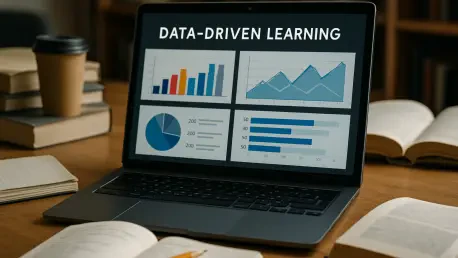Listen to the Article
In the modern era driven by information, big data is reshaping industries worldwide, and higher education is no exception. Colleges and universities are navigating increasingly complex pedagogical landscapes, and data analytics has emerged as a crucial instrument for driving meaningful change. By analyzing large amounts of data, schools can make better decisions that enhance student experiences and improve academic processes.
This article examines how AI-powered insights are shaping the future of higher learning. It examines how institutions utilize data to adapt to shifting demands, innovate in teaching and administration, and address the evolving needs of students and society.
Understanding Data Analytics in Higher Education
In higher education, data analytics involves the systematic collection and examination of large amounts of information. It also includes the interpretation of data generated by students, faculty, and administrative functions. This process enables institutions to extract meaningful insights, which ultimately elevate the overall academic experience.
Several categories of data are typically analyzed in academia:
Student Performance: Metrics such as grades and attendance provide valuable indicators of academic achievement, highlighting areas where students may require additional support.
Admissions Information: Data on prospective students helps institutions refine recruitment strategies and attract candidates who are most likely to succeed.
Financial Data: Evaluating tuition revenue and financial aid distribution ensures institutions manage resources efficiently while targeting support to students who need it most.
Campus Engagement: Tracking student participation in extracurricular activities and campus life provides valuable insights into overall satisfaction and retention. These observations enable institutions to create a more engaging environment.
In essence, data analytics equips higher education institutions to respond effectively to contemporary student expectations and workforce requirements.
Key Areas of Transformation
Data analytics impacts nearly every aspect of the tertiary sector, from personalized learning to resource management. It produces measurable benefits in both academic outcomes and operational efficiency. Below are several critical areas where data-driven insights are reshaping higher education.
Student Performance and Personalization
AI-powered insights help schools support student success by enabling teachers to identify trends in academic performance and intervene promptly when students struggle. Adaptive learning systems utilize this data to tailor course content and recommendations to each student’s specific needs, resulting in more personalized and engaging learning experiences. Smart metrics also enable schools to identify students who may be at risk of falling behind, allowing for targeted support that improves their outcomes and increases their chances of staying in school.
Additionally, data insights help shape curriculum development, ensuring academic programs stay relevant and meet industry needs. This connection helps graduates gain the skills they need for success after graduation. Predictive modeling enables schools to identify factors that influence student retention and achievement, allowing them to develop targeted initiatives that support students at risk.
Analytics also guide admissions and recruitment strategies, allowing schools to attract candidates who meet program requirements and align with the school’s culture. By identifying prospective students likely to succeed, schools can run more effective recruitment campaigns. Moreover, data-driven evaluations extend beyond standardized test scores, enabling admissions teams to assess applicants more thoroughly and build a diverse and capable student body.
Faculty and Staff Management
Analytics also supports faculty and administrative staff by enhancing teaching quality and balancing workloads:
Optimizing Teaching Practices: Data enables instructors to refine teaching strategies, maximizing learning outcomes.
Workload and Performance Tracking: Institutions can manage faculty responsibilities more effectively and accurately assess performance metrics.
Financial Planning and Resource Allocation
Metrics and reporting allow institutions to make more informed financial decisions and optimize resource distribution:
Efficient Resource Management: Insights from data improve budget allocation and operational efficiency.
Financial Aid Optimization: Analyzing aid distribution ensures resources reach students with the greatest need, increasing equity and impact.
Enhancing the Campus Experience
Analytics also enhances the overall student experience, fostering engagement, security, and sustainability:
Smart Campus Technologies: IoT devices improve campus infrastructure, safety, and energy efficiency.
Student Engagement: Insights on extracurricular and co-curricular participation help institutions develop programs that enrich the student experience and support retention.
Benefits of Data Analytics in Higher Education
Integrating data analytics into higher education practices provides numerous advantages, enabling institutions to operate strategically and improve student outcomes:
Enhanced Decision Making:
Real-time, data-informed insights empower leaders to make more informed strategic decisions regarding curriculum design and budgeting. This ensures policies and initiatives are responsive and evidence-based.
Improved Learning Outcomes:
Personalized learning experiences powered by performance tracking improve student engagement and academic performance. Adaptive tools adjust coursework to match student strengths and learning preferences, promoting deeper understanding and better results.
Increased Operational Efficiency:
Metrics and reporting streamline institutional processes, optimizing resource allocation and reducing administrative burdens. Automation and data insights enhance operational effectiveness, resulting in cost savings and more responsive management.
Greater Student Satisfaction and Success:
By providing insights into the student journey, smart metrics enhance engagement and retention. Institutions can proactively address challenges, supporting students to remain enrolled, achieve academic goals, and graduate successfully.
The Complexities of Implementing AI-Driven Metrics in Academia
Data analytics can be very useful in the Tertiary sector, but it also brings challenges, such as constant protection of sensitive student information. Schools must follow strict rules, such as the General Data Protection Regulation and the Family Educational Rights and Privacy Act, to keep this data safe, which can be a complicated process. Additionally, student information is often dispersed across multiple systems. These include admissions records, learning platforms, and administrative files, making it hard to combine the data for a full analysis.
Ethical concerns are also important. Schools must ensure they use data in a transparent and unbiased way. Ultimately, for AI-powered insights to succeed, faculty and staff must be willing to incorporate data into their work. Some may resist because they are unfamiliar with it or worried about changes to their routines. Therefore, ongoing training and support from the institution are essential to encourage acceptance and maximize the benefits of predictive insights.
The Future of Data Analytics in Higher Education
Looking ahead, AI-powered insights are expected to play an increasingly pivotal role in shaping the postsecondary learning landscape. The integration of AI and machine learning will expand the capabilities of predictive evaluation, enabling institutions to provide more personalized insights and actionable information for students and faculty alike. Smart analysis will also support lifelong learning initiatives, helping colleges and universities tailor programs for adult learners and workforce reskilling. These initiatives make sure educational offerings remain aligned with evolving career requirements.
As online and hybrid learning models continue to expand, data-driven strategies will enable institutions worldwide to design more accessible and adaptable learning environments. By leveraging these insights, universities can develop flexible programs that cater to the diverse needs of their student populations, anticipate emerging trends, and remain competitive in an increasingly interconnected educational landscape.









